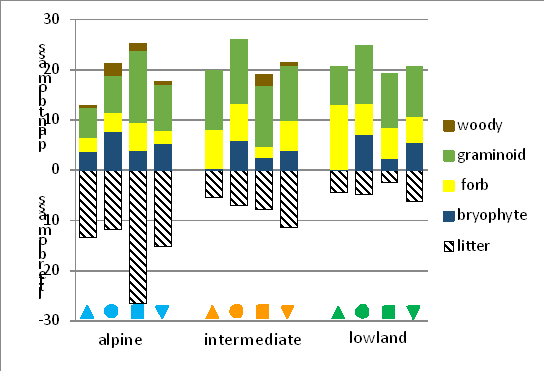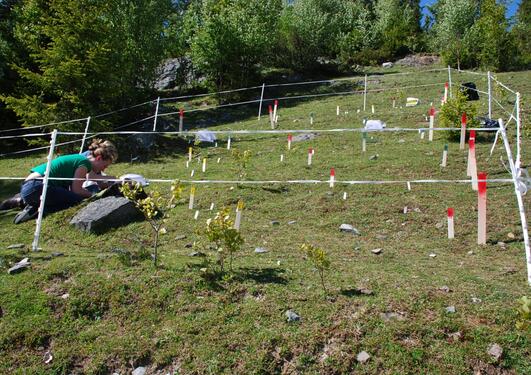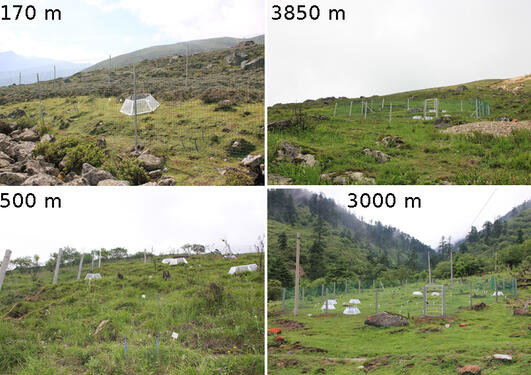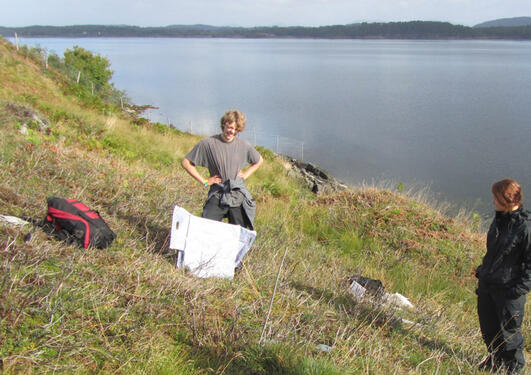FunCaB
The role of Functional group interactions in mediating climate change impacts on the Carbon dynamics and Biodiversity of alpine ecosystems (FunCaB)

Hovedinnhold
Alpine regions contribute important ecosystem functions and services, and are at the same time particularly vulnerable to the ongoing climate change. FunCaB, aims at understanding alpine biodiversity and carbon (C) dynamics under climate change. Specifically, we will disentangle the roles of and interactions between characteristic and important alpine primary producers (graminoids, forbs, woody and non-vascular plants) and decomposer (bacteria vs. fungi) communities under climate change.
Objectives:
- Experimentally assess the effects of temperature and precipitation on the composition and functional groups of alpine ecosystems
- Quantify the impacts and contributions of direct climatic effects vs. indirect effects (through changes in interactions among functional groups)
- Use an Earth System Model to understand the patterns functional diversity and consequences for ecosystem C dynamics and climate feedbacks under different future climate scenarios.
To explore these questions, FunCaB will combine gradient studies, field experiments and model simulations.
- The SeedClim Climate Grid: The western Norwegian fjord landscapes allow us to set up a grid of study sites along independent temperature and precipitation gradients, enabling us to study the unique and combined effects of a warmer and a wetter climate (see box to the right). Our 12 study sites are located in a climate grid where four levels of annual precipitation (600, 1200, 2000 and 2700 mm) are combined with three levels of mean summer temperatures (7.5, 9.5, and 11.5°C) while keeping all other variables as constant as possible. In collaboration with met.no we installed climate stations that record temperature, precipitation, and soil moisture at each site since 2009.
- Removal experiments: Within each site of the climatic grid, we will do fully factorial removal experiments to assess the contributions of, and interactions between the different functional groups of primary producers. In grassland vegetation, we will focous on graminoids, forbs, and non-vascular plants, and in heathland vegetation we will focus on vascular vs non-vascular plants.
- Measurements: In these experiments, we will assess how biodiversity, plant community composition, productivity C fluxes and stocks, and decomposition responds to removal of one or more functional groups. We will maintain the experiments until the new communities have stabilised, which will allow us to assess compensation between different groups, and how this varies with climate.
Additional experiments
We collaborate with SeedClim and other projects using the The SeedClim Climate Grid. We also have opportunities for Master's level studies.
Project partners
Vigdis Vandvik, UiB, project leader, WP1
Kari Klanderud, Norwegian University of Life Sciences (NMBU), WP2, community ecology, interactions
Hanna Lee, Bjerknes Centre for Climate Research, Uni Research (BCCR), WP4, WP5, C stock and flux, Earth System modelling
Lise Øvreås, UIB, WP3, microbial ecology and biodiversity
Brian Enquist, University of Arizona (UA), C stock and flux, traits
Deborah Goldberg, University of Michigan (UM), community ecology, resource allocation, microbial communities
Bente Graae, Norwegian University of Science and Technology (NTNU), C stock and flux, traits
Pascale Michel, New Zealand, bryophyte biodiversity and community composition
Judith Sarneel, Umeå University, litter decomposition
Richard Telford, UiB, numerical methods, biostatistics
Postdocs
Aud Halbritter, phenology and plant-pollinator interactions
PhD students:
Inge Althuizen, C stock and flux, litter decomposition (WP 4) (defended 2018)
Francesca Jaroszynska, biodiversity, community composition, species’ interactions (WP2) (defended 2019)
Master students:
Aksel Anker Henriksen, UiB, drought impacts on grassland vegetation (2014-2016)
Ragnhild Gya, UiB, trait and ecosystem services in alpine grasslands (2015-2017)
Jesslyn Tjendra, UiB, microbial response to graminoid removal (2015-2018)
William Garcia, UiB, microbial response to graminoid removal (2017-2018)
Bachelor student:
Tabea Gallauser, University of Basel, decomposition rate along a temperature and precipitation gradient using the tea bag index
Terezie Nováková, Charles University Prague, responses of plant biomass to climate change: a study along temperature and precipitation gradients
Collaborators:
Olav Skarpaas, Norwegian Institute for Nature Management (NINA), population ecology, demography and modelling
Siri L. Olsen, Norwegian Institute for Nature Management (NINA), population ecology, demography and modelling
Funding source: Norwegian Research Council (RCN) NORKLIMA 2015-2018
Publications
See FunCAB project page on Cristin.
Theses
Althuizen IHJ. 2018. The importance of vegetation functional composition in mediating climate change impacts on ecosystem carbon dynamics in alpine grasslands. PhD Thesis, University of Bergen, Bergen, Norway.
Jaroszynska, F.O.H. 2019. Climate and biotic interactions – drivers of plant community structure and ecosystem functioning in alpine grasslands. PhD Thesis, University of Bergen, Bergen, Norway.




